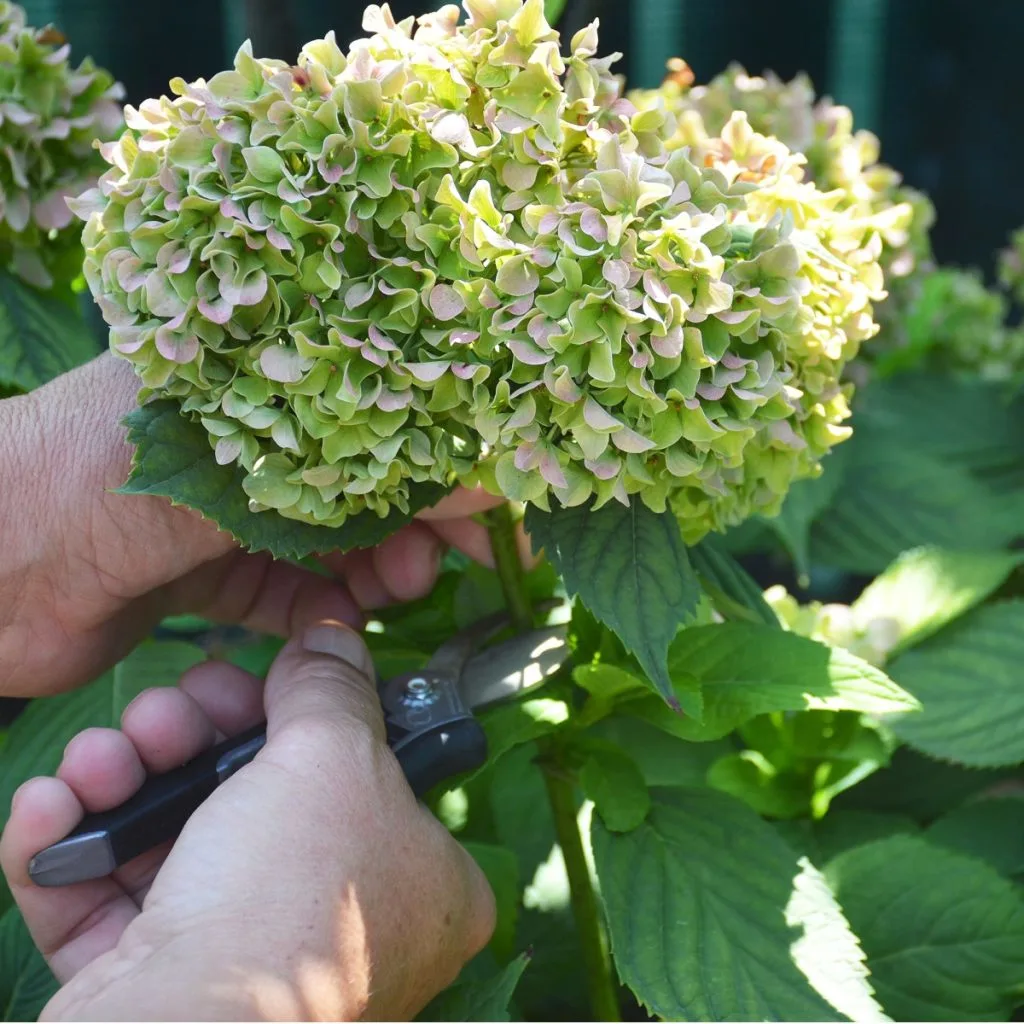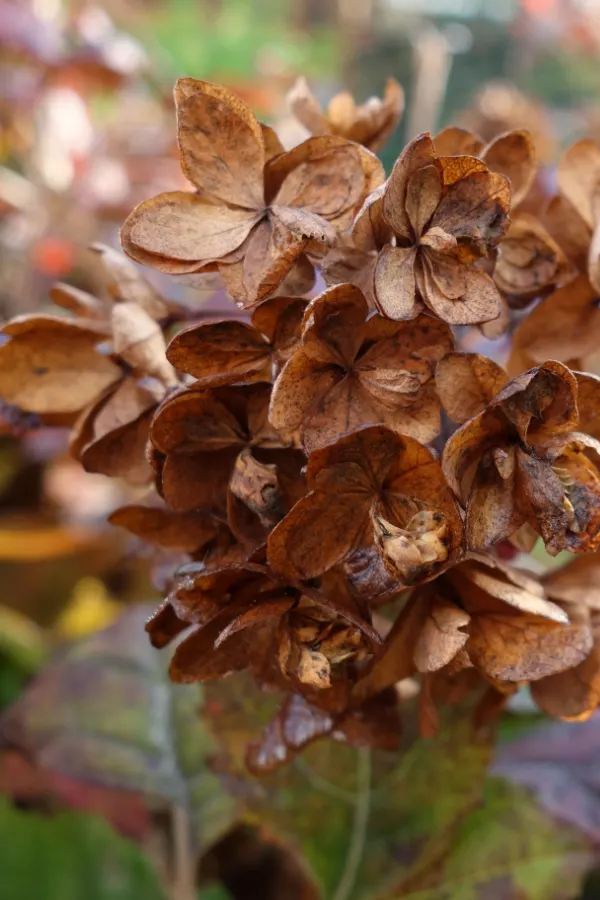Did you know that one of the most important things you can do for your hydrangeas in late summer is to deadhead them?
The large, showy blooms of hydrangeas bring incredible color to flowerbeds and the landscape from late spring through summer – and even into fall. But once those vibrant blooms begin to fade, it’s important to know how and when to remove them.
Deadheading hydrangeas at the right time plays a key role in helping the plant stay healthy and look great. Bet even more, it helps it to prepare to bloom even better next year!

How & Why To Deadhead Hydrangeas In Late Summer
Unlike general pruning of branches and limbs, deadheading focuses on removing just the spent blooms. When done correctly, it not only cleans up the plant, but helps redirect its energy from making seeds into strengthening roots and foliage.
But timing is everything. And when it comes to hydrangeas, understanding the right way to deadhead in late summer can make all the difference in keeping your plant thriving and blooming for seasons to come – or not having any blooms at all!
Here is a closer look at why deadheading is so important in late summer, how to do it safely, and what to avoid so you don’t accidentally remove next year’s blooms.
Why Deadheading Hydrangeas Matters So Much In Late Summer
By the time late summer arrives, many hydrangeas have finished their main flush of blooms. While some varieties may continue to flower into early fall, others begin to slow down and prepare for the cooler months ahead.
When hydrangea blooms begin to fade and turn brown, the plant enters a transition phase. At this stage, the flowers are no longer serving much purpose. However, the plant will still try to push energy toward them in an attempt to produce seeds. That seed production takes energy away from root development, stem strength, and bud formation for next year.

Deadheading helps stop that waste of energy. By simply removing the old, faded blooms, you help the plant conserve valuable resources. Instead of feeding energy into dying flowers, the hydrangea can redirect that strength. Not just for better stems and roots, but also to form new buds that will bloom next year.
Understanding Hydrangea Bloom Cycles
One of the most confusing things about hydrangea care is knowing when and how to prune or deadhead.
That’s because not all hydrangeas bloom the same way. Some form flower buds on old wood, meaning the buds for next year’s flowers are already forming on stems that grew this season. Others bloom on new wood, producing flowers on growth that will appear the same year.
Here’s a simple breakdown:
- Old Wood Bloomers: Bigleaf hydrangeas (Hydrangea macrophylla), Oakleaf hydrangeas (Hydrangea quercifolia), and Mountain hydrangeas (Hydrangea serrata) form buds in late summer and fall on this year’s stems. Pruning them too late will remove next year’s flowers.
- New Wood Bloomers: Panicle hydrangeas (Hydrangea paniculata) and Smooth hydrangeas (Hydrangea arborescens) produce flowers on new growth each spring. These types are more forgiving when it comes to pruning.
The important takeaway? For many common hydrangeas, especially those that bloom on old wood, late summer is the worst time for heavy pruning. But deadheading is still perfectly safe and actually beneficial when done properly. In fact, the best way to keep it simple is to know that no matter the bush type, it’s always safe to deadhead right after a hydrangea blooms!

How To Deadhead Hydrangeas In Late Summer
Deadheading is a simple process, but it’s important to do it the right way to avoid damaging the plant or cutting off new growth. Always start with a clean pair of garden clippers or scissors. Dirty blades can introduce disease to the plant, especially if you’re cutting near young growth. Affiliate Link: Colwelt Compact Garden Loppers Shear Set.
Wipe your tools down with rubbing alcohol or a mild bleach solution before you begin. This is especially important if you’ve recently used them on other plants.
Look for hydrangea flowers that have started to fade or turn brown. Some may be dry and papery, while others may be sagging or losing color. These are the blooms you want to remove. For reblooming varieties, you may see some newer buds forming as well. Be careful to leave these alone so they can continue developing into fall.
Look For The First Set Of Healthy Leaves Below The Bloom
Follow the flower stem down from the bloom to the first full set of healthy, green leaves. This is typically where you’ll make your cut. Snip just above the leaf node (where the leaves meet the stem). This encourages the plant to branch out at that point, rather than leaving behind a dead stem stub.
This method keeps the plant tidy while avoiding the risk of cutting into any new buds that may be forming just below.
You don’t need to deadhead all the blooms at once. Start with the most faded and work your way through the plant. If some flowers still look vibrant or are holding their shape, it’s okay to leave them for now.
Check your plant every few days and remove blooms as they fade. This slow, gradual method keeps the plant looking fresh through the end of summer and into early fall.
What You Shouldn’t Do In Late Summer
Deadheading is safe, but there are a few things you should avoid doing to your hydrangeas in late summer to prevent harming the plant or reducing next year’s blooms.
As tempting as it might be to shape up your hydrangea or cut it back after blooming, late summer is not the time for major pruning. Especially for varieties that bloom on old wood. Cutting back stems now can easily remove the buds that are forming for next season. Once those buds are gone, there’s no way to replace them until the following year.
If you do need to reshape or reduce the size of your plant, the best time to prune is immediately after the plant finishes blooming, typically in mid to late summer. Waiting too long risks cutting off valuable buds.
Don’t Remove Green Growth
While deadheading focuses on cutting just the spent flower heads, you should always avoid cutting into green, leafy stems below them. Green growth is still active and may be working on bud development. Removing it weakens the plant and reduces your chances for blooms.
Only remove the flower and the small portion of stem just above the first healthy leaves. Leave the rest alone.
Late summer is not the time to push a lot of new growth. Avoid feeding hydrangeas with high-nitrogen fertilizer, which encourages soft, leafy growth that may not harden off in time for colder weather.
If your hydrangeas need a boost, opt for a slow-release balanced fertilizer earlier in the season, and stop feeding by late summer. Early spring is the best time to fertilize. See our article: How To Fertilize Hydrangeas In Spring – Get Bigger Blooms Than Ever This Year!
Deadheading hydrangeas in late summer may seem like a minor chore, but it can play a big role in helping your plants stay strong and beautiful. By removing the spent blooms at the right time – and in the right way – you give your hydrangeas a better chance to build up energy, develop next year’s buds, and avoid unnecessary stress!
Simple Garden Life
Follow Our Facebook Page For Even More Great Tips! Simple Garden Life Facebook Page
Simple Garden Life is a website dedicated to keeping gardening fun, simple and enjoyable! We publish two new articles each week along with a new garden podcast episode every two weeks. This article may contain affiliate links.
